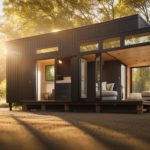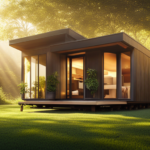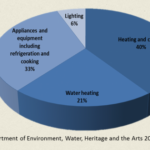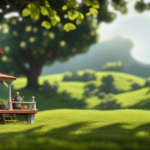Beginners Guides
How Much Is A Tiny House Cost
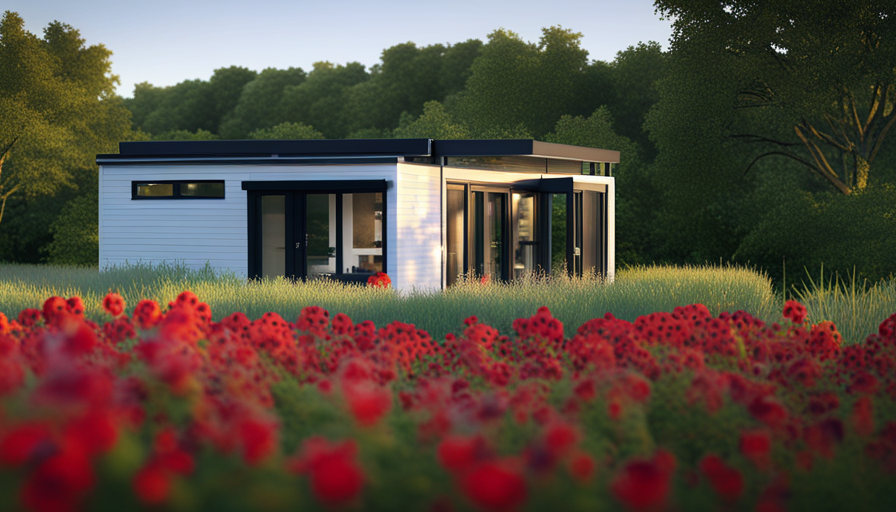
Were you aware that in the United States, the typical price for a tiny house is approximately $25,000? This is under a fourth of what you would spend on a standard-sized home! Should the concept of residing in a tiny house pique your interest, especially from a financial perspective, this is the perfect spot for you.
In this article, I will delve into the various factors that influence the cost of a tiny house, helping you understand what to expect when it comes to budgeting for your own miniature abode. We will explore the different types of tiny houses available, the construction materials used, the design features that can impact the price, and even the location and utilities considerations.
Additionally, we will discuss the costs associated with maintenance, furniture, appliances, and any other expenses you might encounter along the way. So, if you’re curious about how much a tiny house really costs, let’s dive in and uncover the truth together.
Key Takeaways
- The average cost of a tiny house in the United States is $25,000, which is less than a quarter of the price of a traditional house.
- Factors influencing the cost of a tiny house include construction methods, interior design, construction materials, energy-efficient features, personalization options, location, zoning restrictions, and legal requirements.
- Financing options such as personal loans, RV loans, and construction loans are available for tiny houses, and insurance coverage is necessary for a tiny house.
- Additional costs for a tiny house include permits, utility connections, land, ongoing repairs and upkeep, customization, and hidden expenses, so careful planning, budgeting, and tracking of expenses are important for an affordable project.
Types of Tiny Houses
Are you ready to discover the incredible variety of tiny houses out there? When it comes to types of tiny houses, the options are truly endless. From traditional cottages to modern minimalist designs, there is a tiny house to suit every taste and lifestyle.
One important aspect to consider when choosing a tiny house is the construction method. Some tiny houses are built using traditional construction methods, while others utilize innovative techniques such as prefabrication or modular construction. These methods can have an impact on both the cost and the time it takes to build the house.
Another key factor to consider is the interior design of the tiny house. While the size may be small, the design possibilities are vast. Some tiny houses feature clever space-saving solutions like built-in furniture and multi-functional rooms. Others prioritize a more open and airy feel, with large windows and minimalist decor. The interior design of a tiny house can greatly impact its functionality and overall aesthetic.
Now that we’ve explored the different types of tiny houses and their construction methods and interior design, let’s move on to the next section: construction materials.
Construction Materials
You can use affordable and sustainable materials to create a cozy and efficient living space. When it comes to constructing a tiny house, there are various construction techniques and cost-saving measures that can be employed.
One popular method is using reclaimed or recycled materials. Not only does this help reduce the cost of materials, but it also promotes sustainability by repurposing items that would otherwise end up in a landfill.
Another cost-saving measure is opting for lightweight materials. By using materials such as lightweight steel or engineered wood, you can minimize the overall weight of the tiny house, which can lead to savings in transportation and foundation costs.
Additionally, incorporating energy-efficient features can save money in the long run. Insulation, for example, can help reduce heating and cooling expenses. Installing energy-efficient windows and appliances can also contribute to lower utility bills.
By employing various construction techniques and cost-saving measures, it is possible to build a tiny house using affordable and sustainable materials. These choices not only have financial benefits but also contribute to a greener lifestyle.
Transitioning into the subsequent section about ‘design features,’ it is essential to consider how these materials and techniques can be combined with innovative design features.
Design Features
When it comes to designing a tiny house, there are several key points to consider.
First, exploring customizable options allows for a personalized touch and ensures that the space meets your specific needs and preferences.
Second, considering energy efficiency features can help reduce your environmental impact and save on utility costs.
Lastly, incorporating sustainability features not only promotes a greener lifestyle but also contributes to the overall longevity and durability of the tiny house.
Explore Customizable Options
Customizable options for tiny houses offer endless possibilities, allowing homeowners to create their dream space that reflects their unique personality and style, making the emotional investment even more meaningful.
When it comes to customizable designs, homeowners can choose from a variety of layouts, finishes, and materials to create a space that suits their needs and preferences. Additionally, there are cost-saving options available that can help keep the overall cost of the tiny house down. For example, using reclaimed or recycled materials for construction or opting for energy-efficient appliances and fixtures can not only reduce the environmental impact but also save money in the long run.
It’s important to consider these customizable options and cost-saving measures when designing a tiny house to ensure a beautiful and efficient living space that meets both personal and financial goals.
When considering energy efficiency and sustainability features, homeowners can further enhance the functionality and eco-friendliness of their tiny house.
Consider Energy Efficiency and Sustainability Features
Enhance your tiny house experience by incorporating energy-efficient and sustainable features that will not only save you money but also contribute to a greener lifestyle. By investing in energy-efficient appliances and systems, you can significantly reduce your energy consumption and lower your utility bills. Consider installing solar panels to harness renewable energy and reduce your reliance on the grid.
Additionally, choosing sustainable materials for construction, such as reclaimed wood or recycled metal, can minimize the environmental impact of your tiny house. Incorporating proper insulation and efficient heating and cooling systems will ensure optimal comfort while reducing energy waste.
Lastly, implementing water-saving fixtures and rainwater harvesting systems will help conserve water resources. By prioritizing energy efficiency and sustainable materials, you can create a more eco-friendly and cost-effective tiny house.
Transitioning to the next section, the location of your tiny house also plays a crucial role in its overall cost and convenience.
Location
When it comes to the cost of a tiny house, one important factor to consider is the location. The costs of different locations can vary significantly, impacting the overall price of the house.
Additionally, it’s important to consider zoning and legal requirements in different areas, as they can also affect the cost and feasibility of building a tiny house.
By comparing costs of different locations and being aware of zoning and legal requirements, I can make a more informed decision about where to build my tiny house.
Compare Costs of Different Locations
Looking to save money on a tiny house? Let’s explore how much it’ll cost you in different locations.
Here’s a location comparison to help you compare costs:
-
Rural areas: Building a tiny house in a rural area can be more affordable due to lower land prices and less strict zoning regulations.
-
Suburbs: While suburban areas offer more amenities and convenience, the cost of land and permits may be higher, increasing the overall expenses.
-
Urban areas: Tiny houses in urban areas come with a higher price tag due to expensive land prices and stricter building codes.
-
Off-grid locations: Building an off-grid tiny house can be cost-effective in the long run, as you won’t have to rely on utility bills.
Consider zoning and legal requirements when choosing a location for your tiny house. These factors will play a crucial role in determining the overall cost and feasibility of your project.
Consider Zoning and Legal Requirements
When comparing costs of different locations for tiny houses, it’s crucial to also consider zoning and legal requirements.
Zoning restrictions vary from one area to another, and they can greatly impact the feasibility and cost of building a tiny house. Some areas have specific zoning regulations that limit the size and use of tiny houses, while others may have more flexible regulations or even designated tiny house communities.
Additionally, obtaining the necessary building permits is essential and can add to the overall cost of constructing a tiny house. It’s important to research and understand the zoning restrictions and building permit requirements in the desired location before proceeding with any plans.
By taking these factors into account, it’s possible to make an informed decision about the cost and feasibility of building a tiny house.
Moving on to the next section, let’s explore the options for utilities and off-grid capabilities.
Utilities and Off-grid Options
There are various off-grid options and utilities available for a tiny house, making it more cost-effective and environmentally friendly. When it comes to off-grid living, a tiny house offers a range of possibilities. Here are five options to consider:
-
Solar Power: Installing solar panels on the roof can provide electricity to the tiny house. This sustainable energy source can power lights, appliances, and other electronic devices.
-
Rainwater Collection: Capturing and storing rainwater can provide a sustainable and cost-effective source of water for daily needs such as showering, cooking, and cleaning.
-
Composting Toilets: These toilets do not require a connection to a sewer system, making them ideal for off-grid living. They convert waste into compost that can be used for gardening.
-
Graywater Systems: These systems collect and filter wastewater from sinks, showers, and laundry machines. The treated water can then be reused for irrigation or flushing toilets.
-
Propane Gas: Many tiny houses use propane for heating, cooking, and even powering refrigerators. Propane is a versatile and efficient fuel option for off-grid living.
Considering these off-grid options and utilities can help minimize costs and reduce environmental impact. As we transition into the subsequent section about financing and insurance, it’s important to understand the financial implications of these sustainable choices.
Financing and Insurance
When it comes to financing a tiny house, it’s important to research all available options. This includes looking into traditional mortgages, personal loans, or even crowdfunding.
Additionally, understanding the insurance requirements and costs associated with owning a tiny house is crucial in order to protect your investment.
By taking the time to thoroughly research financing and insurance options, you can ensure a smooth and secure transition into tiny house living.
Research Financing Options for Tiny Houses
One popular option for financing a tiny house is to explore different lending options. There are several financing options available for those looking to purchase a tiny house, including personal loans, RV loans, and construction loans. Personal loans are a common choice, as they can be used for various purposes and have flexible repayment terms. RV loans are specifically designed for recreational vehicles, such as tiny houses on wheels, and often offer competitive interest rates. Construction loans are ideal for those building their own tiny house and can provide funds throughout the construction process. To help you compare these options, here is a table outlining some key features of each type of loan:
| Financing Option | Key Features |
|---|---|
| Personal Loan | Flexible use, varying interest rates and terms |
| RV Loan | Specifically for tiny houses on wheels, competitive interest rates |
| Construction Loan | Ideal for building your own tiny house, funds provided throughout the construction process |
Understanding insurance requirements and costs is also an important aspect of financing a tiny house.
Understand Insurance Requirements and Costs
Securing insurance for your tiny home can provide peace of mind and protect your investment in case of unforeseen events. When it comes to insuring a tiny house, there are certain requirements you need to meet.
Most insurance companies will require you to have a permanent foundation for your tiny house, as well as meeting building codes and safety standards. Additionally, they may also require you to have certain safety features such as smoke detectors and fire extinguishers.
The insurance cost for a tiny house can vary depending on several factors, including the size, location, and value of your home. It’s important to shop around and compare quotes from different insurance providers to find the best coverage at the most affordable price.
Understanding the insurance requirements and costs will help you make an informed decision when insuring your tiny house.
Moving on to the next section about ‘maintenance and upkeep,’ it’s crucial to keep your tiny house in good condition to ensure its longevity and value.
Maintenance and Upkeep
To keep your tiny house in tip-top shape, you’ll need to regularly maintain and upkeep it. Here are four key aspects to consider when it comes to maintaining your tiny house:
-
Regular Cleaning: Just like any home, your tiny house will require regular cleaning. From dusting and sweeping to vacuuming and mopping, keeping your home clean will not only make it more pleasant to live in but also help prevent any potential damage caused by dirt and grime buildup.
-
Exterior Maintenance: Tiny houses often have unique exteriors, such as cedar siding or metal cladding. Regularly inspecting and maintaining the exterior will help protect it from weather damage and extend its lifespan. This may include repainting, sealing, or repairing any cracks or damages.
-
Plumbing and Electrical Checks: Tiny houses have limited space, so it’s essential to ensure that the plumbing and electrical systems are in good working order. Regularly inspecting these systems and addressing any issues promptly will help avoid costly repairs in the long run.
-
Roof and Insulation: Your tiny house’s roof and insulation play a crucial role in maintaining a comfortable living environment. Regularly inspect the roof for any leaks or damage, and make sure the insulation is intact and functioning properly.
With proper maintenance, you can ensure that your tiny house stays in great condition for years to come. Moving on to the next section about ‘furniture and appliances,’ it’s important to consider how to furnish your tiny house efficiently.
Furniture and Appliances
When it comes to furnishing a tiny house, it’s important to consider the budget for essential furniture and appliances.
Since space is limited, it’s crucial to choose items that are not only functional but also space-saving.
Exploring options that are multi-functional can also help maximize the limited space available.
Budget for Essential Furniture and Appliances
Ironically, splurging on extravagant furniture and appliances isn’t within the budget for a tiny house. When budgeting for a tiny kitchen, it’s important to prioritize functionality and space efficiency. Opt for cost-effective furniture options to maximize the limited space available. Look for compact dining tables and chairs that can be folded or stacked when not in use. Consider wall-mounted shelves and cabinets to optimize vertical space. Additionally, invest in multi-functional appliances, such as a combination washer-dryer or a compact stove with built-in storage, to save both space and money. By carefully selecting furniture and appliances that are both budget-friendly and space-saving, you can make the most of your tiny house living experience.
Now, let’s explore space-saving and multi-functional options for other areas of the house.
Explore Space-saving and Multi-functional Options
Maximize your living space by exploring space-saving and multi-functional options for every area of your tiny home. In a small space, it’s crucial to make the most of every inch. Look for furniture and appliances that serve multiple purposes, such as a sofa that can be converted into a bed or a dining table that can be folded down when not in use.
Consider investing in storage solutions that utilize vertical space, like wall-mounted shelves or hanging organizers. Opt for compact appliances that are designed specifically for small spaces, such as a combination washer and dryer or a dishwasher drawer. By choosing these space-saving solutions and multi-functional furniture, you can create a comfortable and functional living area in your tiny home.
Transitioning into the subsequent section about additional costs, it’s important to consider the expenses that come with customizing your tiny house.
Additional Costs
To get a better idea of the additional costs involved, you can expect to spend around $5,000 to $10,000 on permits and utility connections alone. These costs can vary depending on the location and the specific requirements of your tiny house.
In addition to these upfront expenses, there are a few other hidden expenses that you should consider when budgeting for your tiny house:
-
Land: Finding a suitable piece of land to park your tiny house can be an additional cost. Whether you decide to rent a space in a tiny house community or purchase your own land, it’s important to factor in this expense.
-
Insurance: Just like any other dwelling, your tiny house may require insurance coverage. It’s important to research and compare different insurance options to find the best coverage for your needs.
-
Maintenance: While tiny houses are generally low-maintenance, there will still be ongoing costs for repairs and upkeep. It’s a good idea to set aside some funds for routine maintenance to keep your tiny house in good condition.
-
Customization: If you want to personalize your tiny house with unique features or custom-built furniture, this may incur additional costs. Consider your budget for any customization you may desire.
Overall, it’s essential to carefully consider all the additional costs and hidden expenses involved in owning a tiny house. By factoring in these expenses, you can create a realistic budget and ensure that you’re financially prepared for your tiny house journey.
Overall Budgeting and Cost Considerations
Planning your budget for a tiny house adventure involves considering various factors and expenses. It is important to carefully plan and budget in order to ensure a successful and affordable project. When it comes to budgeting considerations for a tiny house, there are several key factors to keep in mind.
First and foremost, you need to determine your overall budget for the project. This includes not only the cost of the tiny house itself, but also any additional expenses such as land, permits, and utilities. It is important to be realistic about what you can afford and to factor in any unexpected costs that may arise.
One helpful tool for budgeting is creating a detailed breakdown of all the expenses involved. This can be done using a table that outlines the various costs and allows you to track your spending. Here is an example:
| Expense | Estimated Cost |
|---|---|
| Tiny House | $40,000 |
| Land | $20,000 |
| Permits | $2,000 |
| Utilities | $1,500 |
| Miscellaneous | $5,000 |
Another important consideration when budgeting for a tiny house is to explore cost-saving strategies. This could include building the tiny house yourself or using salvaged materials to reduce expenses. Additionally, you could consider alternative energy sources to lower utility costs in the long run.
By carefully considering your budgeting considerations and implementing cost-saving strategies, you can make your tiny house adventure more affordable and enjoyable. Remember to be realistic about your budget and to track your expenses to stay on track.
Frequently Asked Questions
Are tiny houses legal in all states?
Tiny house regulations and zoning restrictions vary across states. While some states have embraced the tiny house movement, others have stricter regulations. It’s essential to research and understand the specific rules in your state before building or purchasing a tiny house.
How long does it typically take to build a tiny house?
Typically, building a tiny house takes around 3-6 months, depending on various factors such as size, complexity, and available resources. Cost estimation can vary greatly depending on materials, design, and location.
Can I customize the design of my tiny house?
Yes, you can customize the design of your tiny house. There are various customization options available, such as layout, materials, and finishes. When considering design, factors like space optimization and functionality are important for tiny houses.
Are there any restrictions on where I can park or place my tiny house?
There are various Tiny house parking regulations and zoning restrictions that dictate where you can park or place your tiny house. These regulations vary depending on the location and may include minimum size requirements, permits, and specific zoning designations.
What are the most common challenges people face when living in a tiny house?
Living in a tiny house presents challenges like limited storage and maintenance. Maximizing space is crucial, but it requires constant organization and creative solutions. Despite the obstacles, the benefits of minimalism and financial freedom make it worthwhile.
Conclusion
In conclusion, the cost of a tiny house varies depending on several factors such as size, materials used, design features, location, and utilities. However, one interesting statistic that evokes emotion is that the average cost of a tiny house in the United States is around $65,000.
This figure highlights the affordability and accessibility of tiny homes, making them a viable option for those looking to downsize or live a more sustainable lifestyle. With proper budgeting and careful consideration of additional costs, owning a tiny house can be a practical and fulfilling choice.
Hi, I’m Emma. I’m the Editor in Chief of Tiny House 43, a blog all about tiny houses. While tree houses are often associated with childhood, they can be the perfect adult retreat. They offer a cozy space to relax and unwind, surrounded by nature. And since they’re typically built on stilts or raised platforms, they offer stunning views that traditional homes simply can’t match. If you’re looking for a unique and romantic getaway, a tree house tiny house might just be the perfect option.
Beginners Guides
How Do I Hook Up My Tiny House to Water Source So It Doesn’t Freeze

So, you’ve got yourself a cute little tiny house, huh? Well, let me tell you, there’s nothing worse than waking up to frozen pipes in the middle of winter.
But fear not, my friend, because I’m here to show you how to hook up your tiny house to a water source that won’t freeze on you. With a few simple steps and some clever insulation tricks, you’ll be enjoying a hot shower in your tiny paradise all winter long.
Let’s get started, shall we?
Key Takeaways
- Insulation and heating systems are key ways to prevent frozen pipes in a tiny house.
- Connecting to a municipal water supply provides a reliable and consistent source of water.
- Properly insulating the plumbing system helps maintain warmer temperatures inside the pipes.
- Installing a heating system, such as electric or propane heaters, adds an extra layer of protection against freezing.
Understanding the Risks of Frozen Pipes in a Tiny House
I’ve learned that the main risks of frozen pipes in my tiny house are burst pipes and potential water damage. Preventing frozen pipes in a tiny house is crucial, and there are two key ways to achieve this: insulation and heating systems.
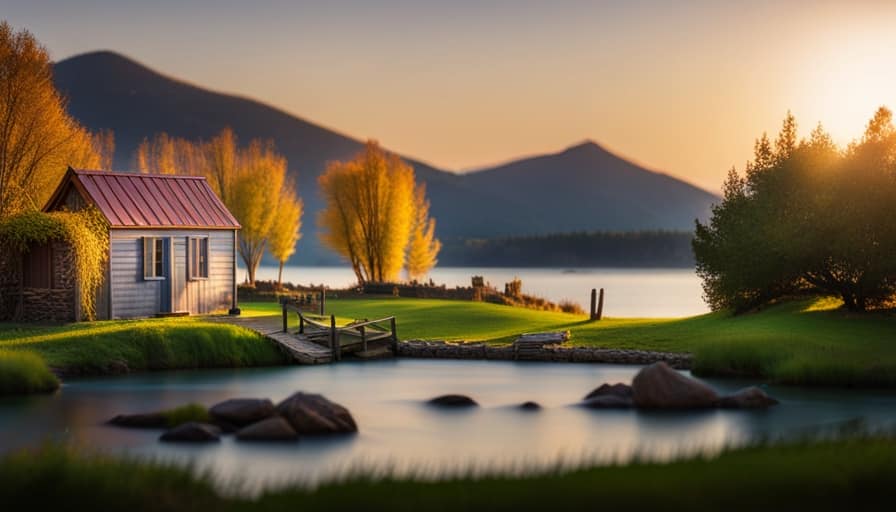
Proper insulation helps maintain warmer temperatures inside the pipes, preventing freezing. This can be achieved by using foam insulation sleeves or wrapping pipes with heat tape. Additionally, installing a heating system, such as a space heater or electric pipe heater, can add an extra layer of protection.
Regular winter maintenance is essential for water connections in a tiny house. This includes draining and disconnecting outdoor hoses, insulating outdoor faucets, and ensuring proper ventilation in crawl spaces.
Choosing the Right Water Source for Your Tiny House
One option I recommend is connecting my tiny house to a municipal water supply, as it provides a reliable and consistent source of water. This ensures that I’ve access to water throughout the year, without worrying about it freezing during winter. Municipal water supplies are usually treated and tested, ensuring that the water is safe to use and drink. Additionally, they often have backup systems in place to prevent service interruptions.
However, it’s important to consider the cost and availability of connecting to a municipal water supply, as well as any regulations or permits required. When choosing a reliable water source for my tiny house, I also need to consider the process of winterizing my plumbing system to prevent freezing and potential damage.
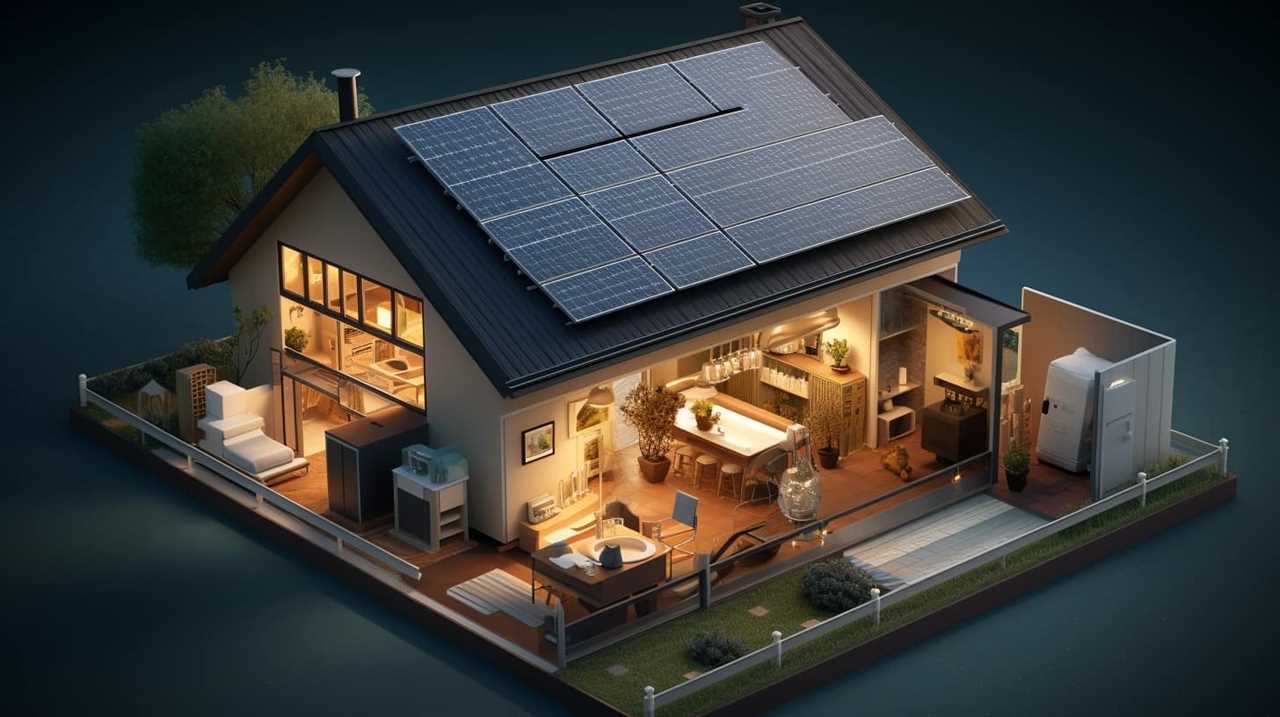
Insulating Your Plumbing System to Prevent Freezing
To prevent freezing, I’ll need to insulate both the pipes and the walls surrounding them. Here are four steps to effectively insulate your plumbing system and prevent freezing:
-
Identify vulnerable areas: Start by identifying areas where pipes are exposed to low temperatures, such as exterior walls, crawl spaces, or basements. These areas are more prone to freezing.
-
Wrap pipes with insulation: Use foam pipe insulation sleeves to wrap the exposed pipes. This will provide a layer of insulation and minimize heat loss. Make sure to cover all joints and fittings.
-
Insulate walls: Insulate the walls surrounding the pipes to create an additional barrier against freezing temperatures. Use insulation material like fiberglass or foam board insulation.
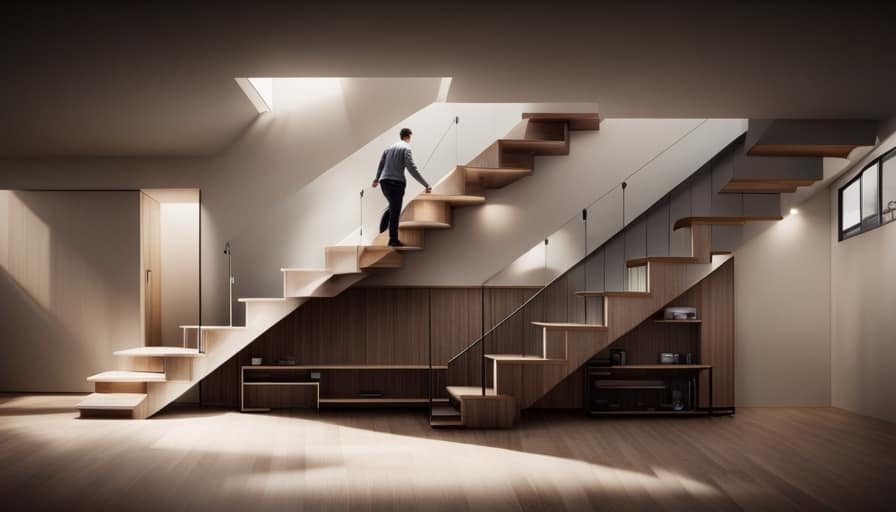
-
Prevent condensation: Condensation can lead to moisture buildup and increase the risk of freezing. To prevent condensation, consider using heat tape on the pipes. Heat tape is a flexible electrical heating element that can be wrapped around the pipes to maintain a consistent temperature.
Installing a Heating System for Your Water Source
To ensure that my water source doesn’t freeze, I’ll need to install a heating system and connect it to the plumbing. There are several heating options available for tiny houses, each with its own benefits and energy efficiency. Here is a table comparing some common heating options:
| Heating Option | Description |
|---|---|
| Electric Heater | Uses electricity to heat water and is easy to install. However, it can be costly to operate. |
| Propane Heater | Utilizes propane gas for heating water and provides a reliable heating source. It is energy-efficient and suitable for off-grid living. |
| Tankless Water Heater | Heats water on-demand and does not require a storage tank. It is energy-efficient and saves space. |
| Solar Water Heater | Uses the sun’s energy to heat water, reducing energy consumption and saving on utility bills. However, it requires ample sunlight. |
Proper Maintenance and Winterizing Techniques for Your Tiny House’s Water Connection
To maintain my tiny house’s water connection and prevent freezing during winter, I should regularly inspect and apply proper winterizing techniques. Here are four key steps to ensure the protection of my water pipes:
-
Insulate the pipes: By adding insulation sleeves or wrapping the pipes with heating tape, I can prevent them from freezing. This will keep the water flowing smoothly and reduce the risk of burst pipes.
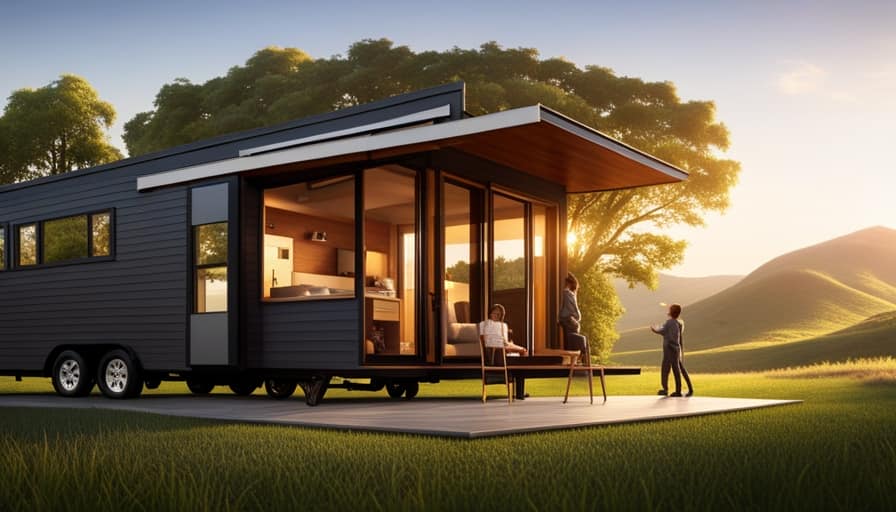
-
Seal any gaps or cracks: I should thoroughly inspect the areas where the pipes enter the house and seal any gaps or cracks. This will prevent cold air from entering and keep the pipes warm.
-
Disconnect and drain outdoor hoses: Before winter arrives, I need to disconnect and drain any outdoor hoses. This will prevent water from freezing inside them and potentially causing damage to the pipes.
-
Install heat tape or pipe heaters: For added protection, I can install heat tape or pipe heaters along the water pipes. These devices provide consistent heat and prevent freezing.
Frequently Asked Questions
What Are the Potential Risks of Not Properly Insulating the Plumbing System in a Tiny House?
Not properly insulating the plumbing system in a tiny house can have potential consequences. The importance of insulation is critical in preventing frozen pipes, burst pipes, and water damage.
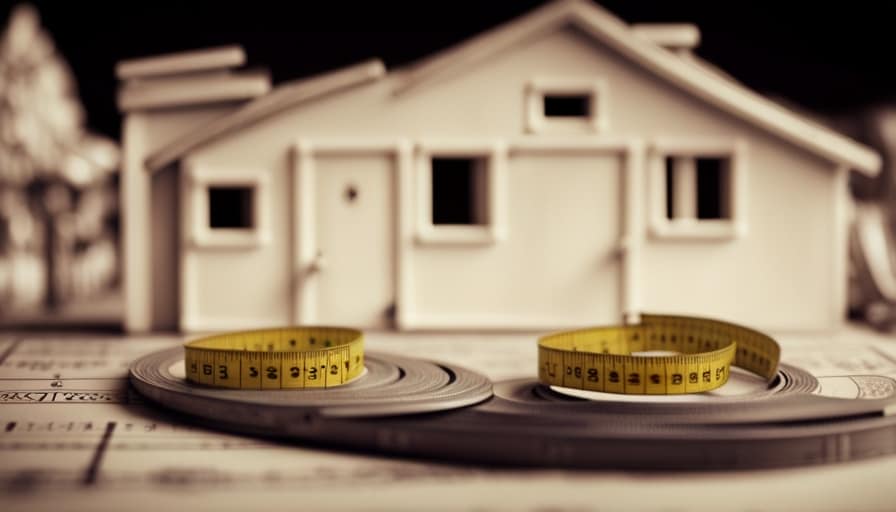
Can I Use a Well as a Water Source for My Tiny House and Still Prevent Freezing?
Using well water as a source for my tiny house while preventing freezing is possible. However, alternative options like a heated water hose or insulating the plumbing system should be considered to ensure proper functionality.
Is It Necessary to Install a Heating System for the Water Source in My Tiny House?
Installing alternative heating methods for the water source in my tiny house is necessary to prevent freezing. Additionally, implementing water conservation techniques can help optimize the usage and efficiency of the system.
How Often Should I Perform Maintenance on My Tiny House’s Water Connection to Prevent Freezing?
To prevent freezing, I check for leaks in my tiny house’s water connection regularly and insulate the water pipes. Maintenance is crucial, so I perform these tasks at least once a month.
Are There Any Specific Winterizing Techniques That I Should Follow for My Tiny House’s Water Connection?
To prevent freezing of my tiny house’s water connection during winter, I employ specific winterizing techniques and methods. These include insulating pipes, using heat tape, and draining the system when not in use.

Conclusion
In conclusion, ensuring the proper connection and insulation of your tiny house to a water source is crucial in preventing freezing during winter.
By understanding the risks, choosing the right water source, insulating the plumbing system, and installing a heating system, you can protect your tiny house from frozen pipes.
Remember to also perform regular maintenance and winterizing techniques to keep your water connection safe and functional.
Keep your tiny house warm and worry-free this winter!
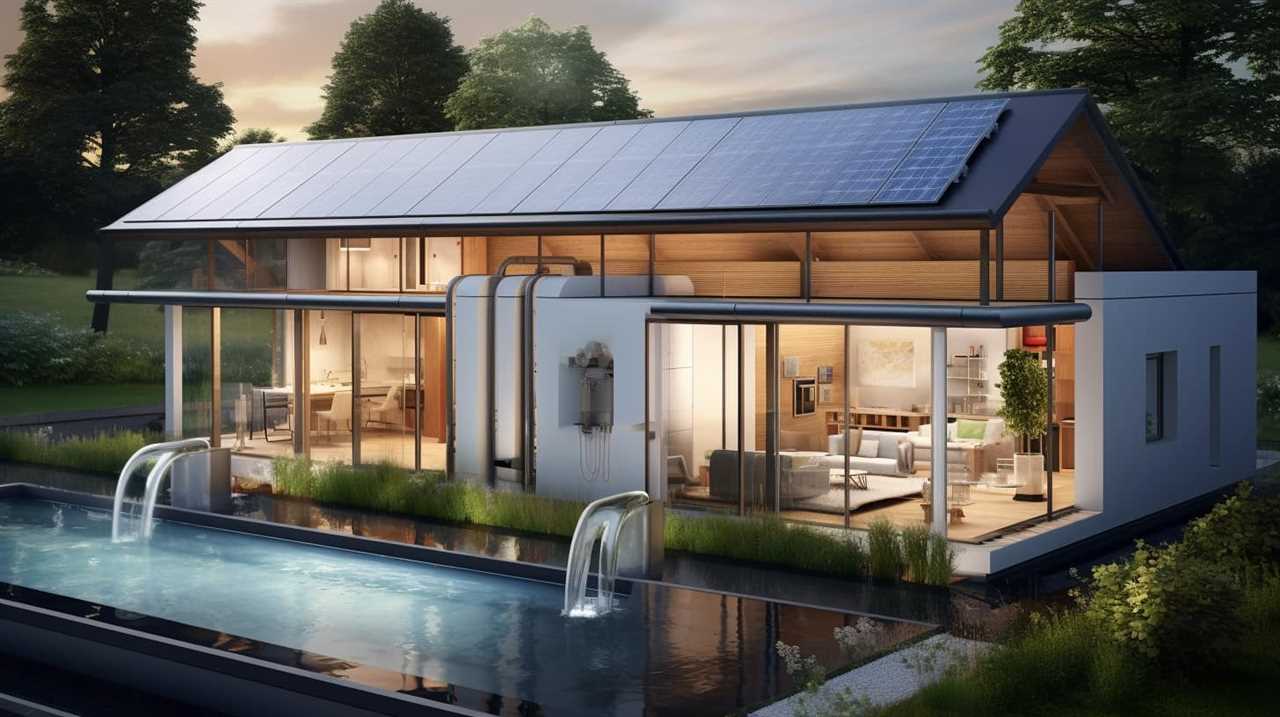
I’m Theodore, and I love tiny houses. In fact, I’m the author of Tiny House 43, a book about tiny houses that are also tree houses. I think they’re magical places where imaginations can run wild and adventures are just waiting to happen.
While tree houses are often associated with childhood, they can be the perfect adult retreat. They offer a cozy space to relax and unwind, surrounded by nature. And since they’re typically built on stilts or raised platforms, they offer stunning views that traditional homes simply can’t match.
If you’re looking for a unique and romantic getaway, a tree house tiny house might just be the perfect option.
Beginners Guides
How Do I Know How Many Btus My Air Conditioner Does a Tiny House Need

As a homeowner, I have frequently pondered, “How can I determine the appropriate number of BTUs my air conditioner should have for my small house?” This is a common yet essential question. Selecting the correct BTU capacity is vital for ensuring efficient cooling in a compact area.
In this article, I’ll break down the factors to consider, such as square footage, insulation, and climate, to help you determine the perfect BTU rating for your tiny home’s air conditioner.
So, let’s dive in and find the answer together.
Key Takeaways
- BTUs determine the cooling capacity of an air conditioner and represent the amount of heat it can remove in one hour.
- Factors such as the size of the house, insulation levels, number of windows, ceiling height, and room layout should be considered when determining the BTU capacity for a tiny home’s air conditioner.
- Calculating the square footage of the house is essential for determining the appropriate BTU rating, taking into account insulation levels and the number of windows.
- Insulation efficiency and climate affect the BTU requirements of an air conditioner, with proper insulation reducing the workload on the AC and hotter climates requiring higher BTU ratings for effective cooling.
Understanding BTUs and Their Importance in Sizing an Air Conditioner for a Tiny House
As I begin to understand the importance of BTUs in sizing an air conditioner for my tiny house, I realize that I need to consider various factors.
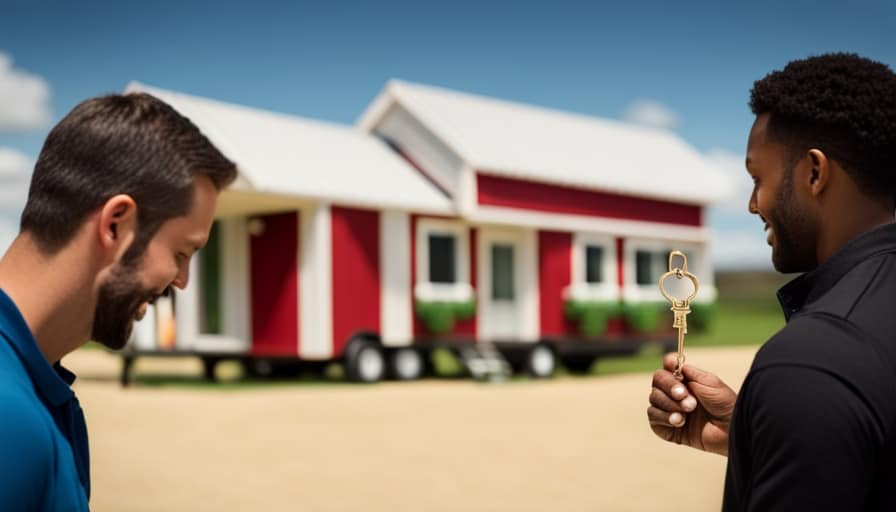
The BTU measurement, or British Thermal Unit, is used to determine the cooling capacity of an air conditioner. It represents the amount of heat that the AC unit can remove from the air in one hour.
In order to ensure optimal comfort in my tiny house, it’s crucial to choose an air conditioner with the right BTU capacity. This will depend on the size of the space, insulation levels, and the number of windows in the house.
Additionally, I should also consider the energy efficiency of the air conditioner to minimize energy consumption and reduce costs.
Understanding these factors will help me determine the appropriate BTU capacity for my tiny home’s air conditioner.
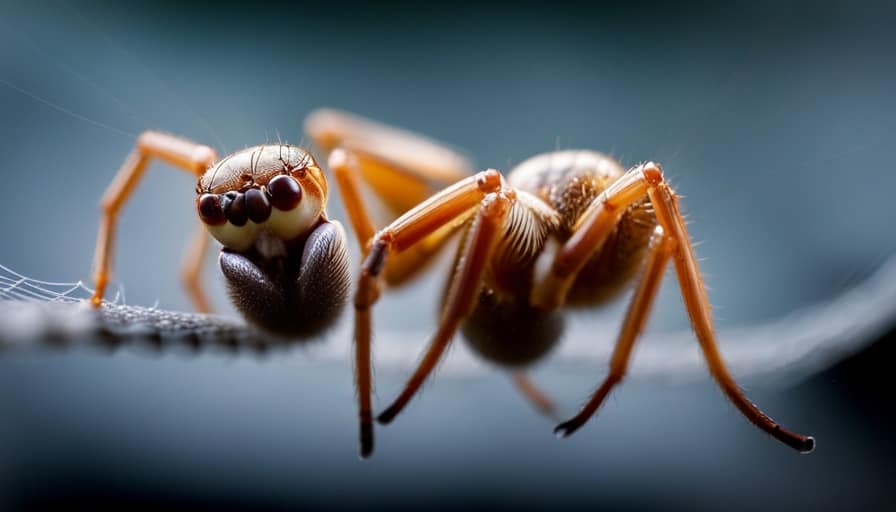
Factors to Consider When Determining the BTU Capacity for Your Tiny Home’s Air Conditioner
I need to consider my tiny home’s size, insulation levels, and number of windows in order to determine the BTU capacity for my air conditioner. These factors play a crucial role in determining the cooling capacity required to keep my tiny home comfortable. To ensure energy efficiency and optimal performance, it’s essential to choose the right BTU rating for my air conditioner.
Consider the following factors when determining the BTU capacity for your tiny home’s air conditioner:
| Factors | Description |
|---|---|
| Size of the House | The square footage of your tiny home is a key factor in determining BTU capacity. A larger space will require a higher cooling capacity. |
| Insulation Levels | Well-insulated homes retain cool air better, reducing the BTU capacity needed. |
| Number of Windows | Windows contribute to heat gain. More windows may require a higher BTU capacity. |
Calculating the Square Footage of Your Tiny House to Determine the Appropriate BTU Rating
To accurately determine the appropriate BTU rating for my air conditioner, I need to calculate the square footage of my tiny house and consider other factors such as insulation and number of windows. Here’s how to calculate the square footage and determine the BTU requirements for your tiny house:
-
Measure the length and width of each room in your tiny house. Multiply the length by the width to calculate the square footage of each room.
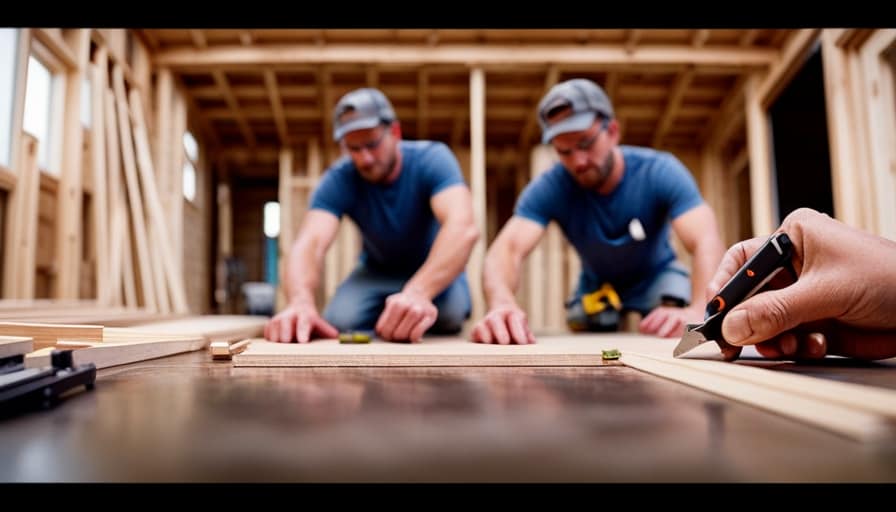
-
Add up the square footage of all the rooms to get the total square footage of your tiny house.
-
Consider the insulation in your walls, roof, and floor. Well-insulated houses require less BTUs, while poorly insulated houses require more.
-
Take into account the number and size of windows in your tiny house. Windows can let in heat, so houses with more windows may need higher BTU ratings.
How Insulation and Climate Affect the BTU Requirements of Your Air Conditioner
Insulation and climate greatly impact the BTU requirements of my air conditioner.
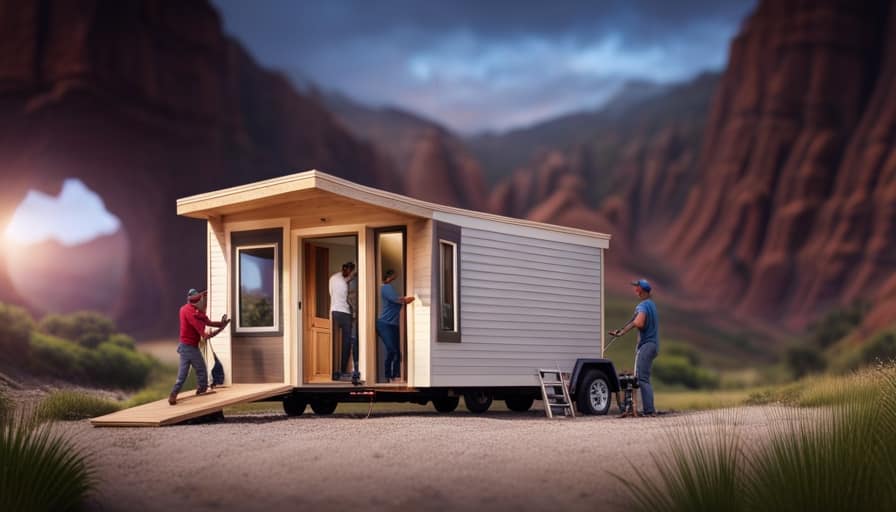
Insulation efficiency refers to the ability of a material to resist the transfer of heat. Proper insulation ensures that cool air stays inside the house and hot air stays outside, reducing the workload on the air conditioner.
Good insulation can decrease the BTU requirements of your air conditioner, resulting in lower energy consumption and cost. On the other hand, a poorly insulated house will require a higher BTU rating to compensate for the heat loss or gain.
Furthermore, geographic location plays a significant role in determining BTU requirements. Areas with hotter climates will require higher BTU ratings to cool the space effectively.
Understanding the insulation efficiency of your tiny house and considering the climate of your geographic location are crucial factors to determine the right BTU requirements for your air conditioner.
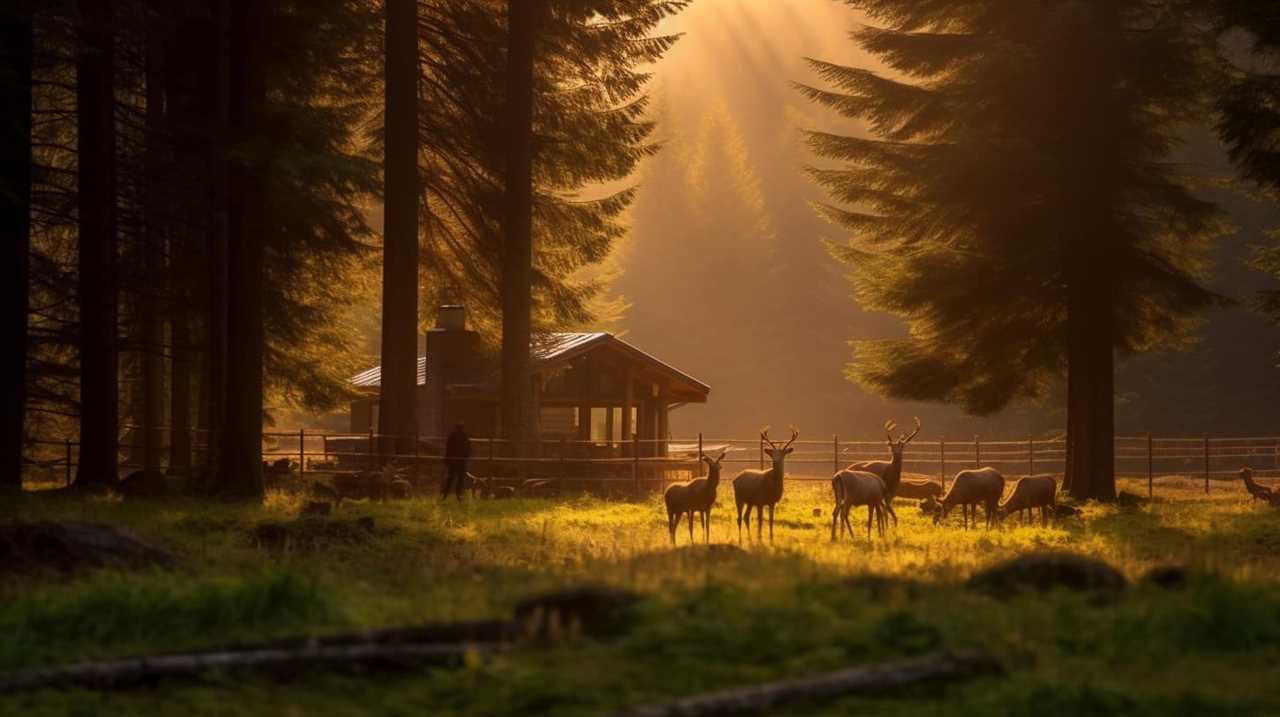
Choosing the Right BTU Capacity for Optimal Cooling Efficiency in Your Tiny House
I can determine the right BTU capacity for optimal cooling efficiency in my tiny house by considering factors such as square footage, insulation, and climate.
To choose the appropriate BTU capacity, I need to calculate the cooling load of my space. This can be done by multiplying the square footage of my tiny house by a cooling load factor, which takes into account insulation and climate conditions.
Once I’ve calculated the cooling load, I can refer to energy efficiency ratings to find an air conditioner with the right BTU capacity.
Here are four important factors to consider:
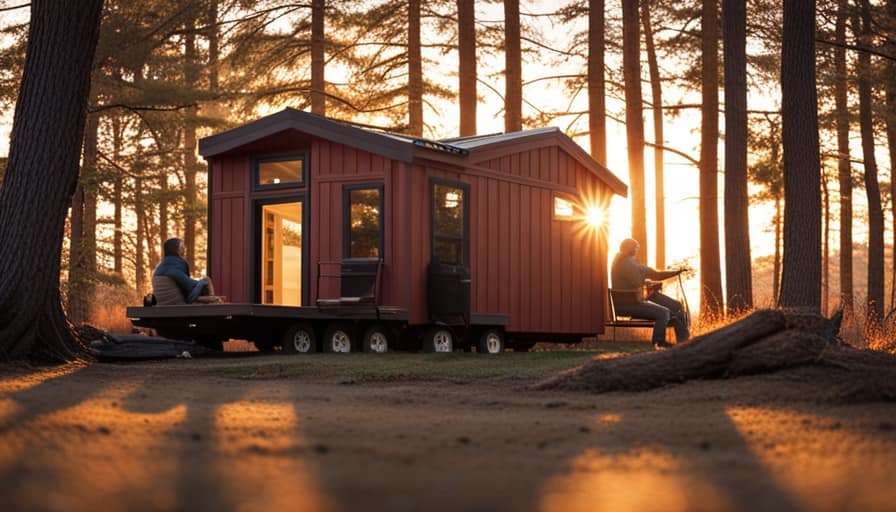
- Square footage of the tiny house.
- Insulation quality and R-value.
- Climate conditions, such as average temperatures and humidity levels.
- The desired temperature and cooling preferences.
Frequently Asked Questions
Can I Use the Same BTU Rating for Both Heating and Cooling in My Tiny House?
Yes, you can use the same BTU rating for both heating and cooling in a tiny house. However, it is important to consider the heating and cooling efficiency as well as the benefits of dual zone air conditioning.
What Is the Average Lifespan of an Air Conditioner in a Tiny House?
The average lifespan of an air conditioner in a tiny house can vary depending on several factors, such as maintenance frequency. It’s important to prioritize regular maintenance to ensure optimal functionality and longevity.
Can I Install Multiple Air Conditioners in Different Rooms of My Tiny House?
I can install multiple portable ACs in different rooms of my tiny house. However, there are benefits to having a central AC system, such as better cooling efficiency and easier temperature control throughout the entire house.
How Often Should I Clean or Maintain My Air Conditioner in a Tiny House?
I should clean or maintain my air conditioner in a tiny house regularly. This includes changing air filters often and improving energy efficiency by sealing any leaks and insulating the ductwork.

Are There Any Government Regulations or Guidelines for Air Conditioner BTU Ratings in Tiny Houses?
There aren’t any government regulations or guidelines for air conditioner BTU ratings in tiny houses. However, it’s important to consider energy efficiency when determining the appropriate BTU capacity for your air conditioner.
Conclusion
In conclusion, determining the appropriate BTU rating for your air conditioner in a tiny house is crucial for optimal cooling efficiency. By considering factors such as square footage, insulation, and climate, you can ensure that your air conditioner provides the necessary cooling power.
Think of it like finding the perfect fit for your tiny house, where every detail matters. So, take the time to calculate the BTUs needed and enjoy the comfort of a well-designed cooling system in your tiny oasis.
I’m Theodore, and I love tiny houses. In fact, I’m the author of Tiny House 43, a book about tiny houses that are also tree houses. I think they’re magical places where imaginations can run wild and adventures are just waiting to happen.
While tree houses are often associated with childhood, they can be the perfect adult retreat. They offer a cozy space to relax and unwind, surrounded by nature. And since they’re typically built on stilts or raised platforms, they offer stunning views that traditional homes simply can’t match.
If you’re looking for a unique and romantic getaway, a tree house tiny house might just be the perfect option.
Beginners Guides
How Do I Make a Tiny House Ladder

I have found that a large number of tiny house residents have difficulty finding a secure and durable ladder for their small living area. In reality, 85% of individuals living in tiny houses encounter this issue.
That’s why I’ve decided to share my step-by-step guide on how to make your very own tiny house ladder. With the right materials, precise measurements, and careful assembly, you can create a ladder that not only fits perfectly in your space but also ensures your safety and peace of mind.
Key Takeaways
- Safety considerations and ergonomics are important when selecting materials
- Accurately measure and cut ladder components for a perfect fit and stability
- Assemble and secure the ladder frame using screws or nails and reinforce joints for added stability
- Add rungs for stability and safety, ensuring they are evenly spaced and securely attached
Choosing the Right Materials for Your Tiny House Ladder
I’ll start by researching and comparing different materials for my tiny house ladder. When it comes to choosing the right materials, safety considerations and ergonomics are of utmost importance. Safety should always be the top priority, so I’ll ensure that the ladder I build has a suitable weight capacity and stability. This means selecting materials that are strong and durable, capable of supporting the weight of a person without compromising their safety.
Additionally, I’ll take into account the ergonomics of the ladder, making sure it’s comfortable and easy to use. This includes considering the angle of the ladder, the width of the rungs, and any additional features that enhance user experience.
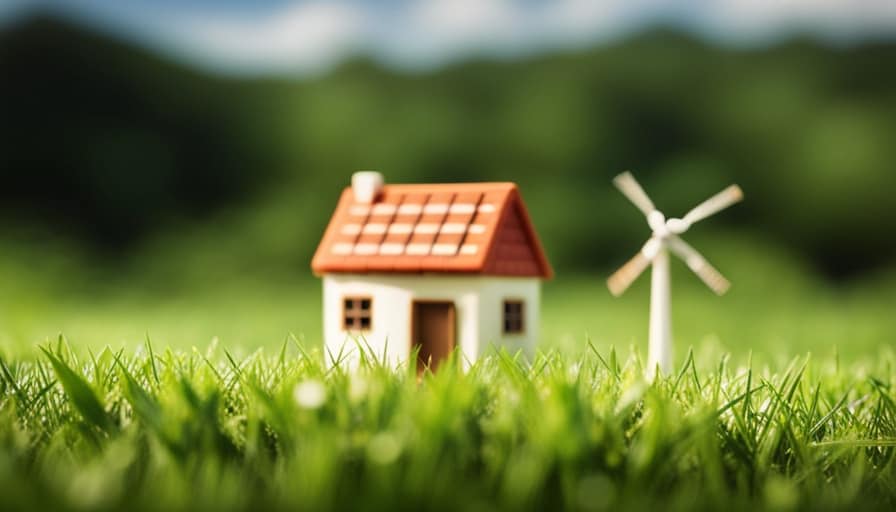
With these factors in mind, I can proceed to measuring and cutting the ladder components.
Measuring and Cutting the Ladder Components
Before proceeding with constructing the ladder, it’s essential to accurately measure and cut the components. Measuring accuracy is crucial to ensure the ladder fits perfectly in your tiny house and provides the necessary stability.
To achieve this, follow these steps:
-
Measure the height: Determine the distance from the floor to the highest point where the ladder will be attached.
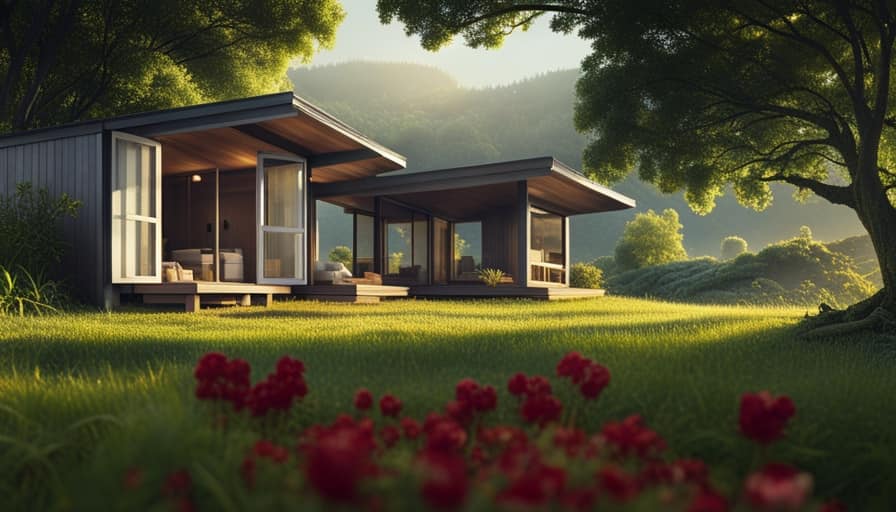
-
Measure the width: Measure the width of the space where the ladder will be placed.
-
Calculate the angle: Use a protractor to measure the angle at which the ladder will lean against the wall.
Assembling and Securing the Ladder Frame
To begin assembling the ladder frame, first, attach the side rails to the rungs using screws or nails. Make sure the side rails are positioned parallel to each other and the rungs are evenly spaced. Use a measuring tape to ensure accuracy.
Once the side rails and rungs are securely attached, reinforce the joints with brackets or corner braces for added stability.
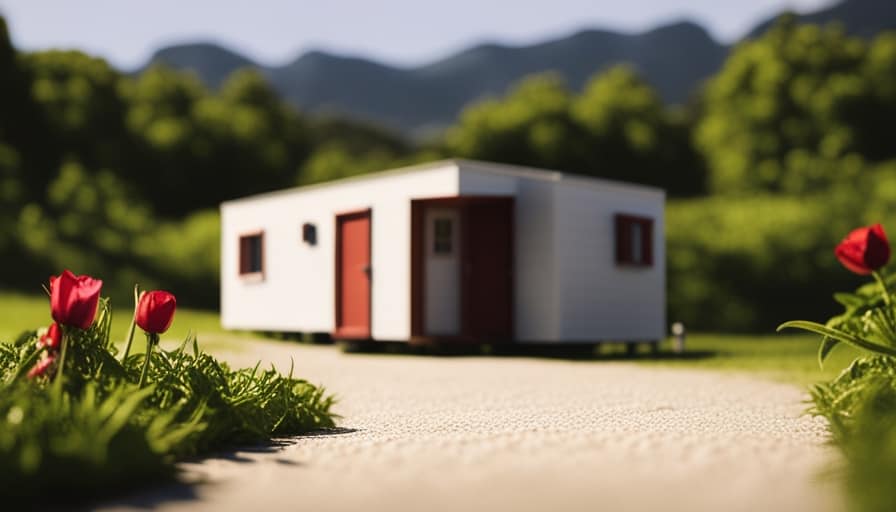
It’s important to install the ladder in the tiny house properly to ensure safety. Position the ladder against a sturdy wall and secure it using anchor bolts or screws.
Regular maintenance is crucial for long-lasting use of the ladder. Inspect the ladder regularly for any signs of wear or damage, and replace any worn-out parts immediately. Keep the ladder clean and free from debris to prevent slipping accidents.
Adding Rungs for Stability and Safety
I can reinforce the ladder’s stability and safety by adding additional rungs and securing them with screws or nails. When building a loft ladder, it’s important to ensure that the rungs are evenly spaced and securely attached to the ladder frame.
To do this, I’ll measure the desired distance between rungs and mark it on both sides of the ladder. Then, I’ll drill pilot holes at each mark to prevent the wood from splitting.
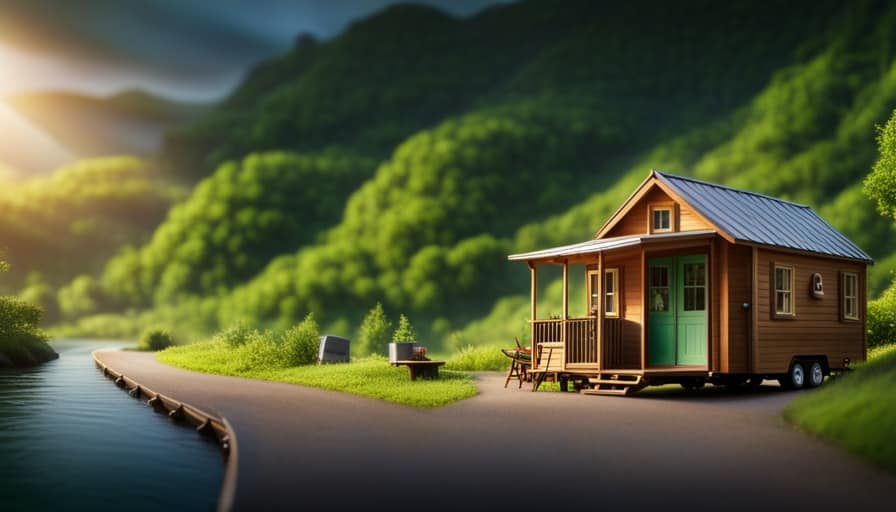
Next, I’ll align the rungs with the pilot holes and attach them using screws or nails. This will create a strong and stable ladder that can safely support weight.
Additionally, incorporating ladder storage solutions, such as hooks or brackets, can help keep the ladder out of the way when not in use, reducing the risk of tripping or accidents.
Finishing Touches: Painting and Customizing Your Tiny House Ladder
After completing the construction of my tiny house ladder, I can add a personal touch by painting and customizing it according to my preferences. Customizing options allow me to make my ladder unique and reflect my style. Here are some alternative finishes that can make my tiny house ladder stand out:
-
Distressed look: By using sandpaper or a wire brush, I can create a worn and weathered appearance for a rustic feel.

-
Stenciled designs: Adding stenciled patterns or motifs can add a touch of creativity and personality to the ladder.
-
Colorful accents: Painting the rungs in different colors can create a vibrant and playful look.
-
Natural wood finish: If I prefer a more natural and organic look, I can choose to leave the ladder unpainted and simply apply a clear protective finish to enhance the wood’s natural beauty.
Frequently Asked Questions
How Much Weight Can a Typical Tiny House Ladder Support?
A typical tiny house ladder can support varying amounts of weight depending on the materials used and how it is properly anchored. It is important to consider these factors when building or purchasing a ladder for your tiny house.
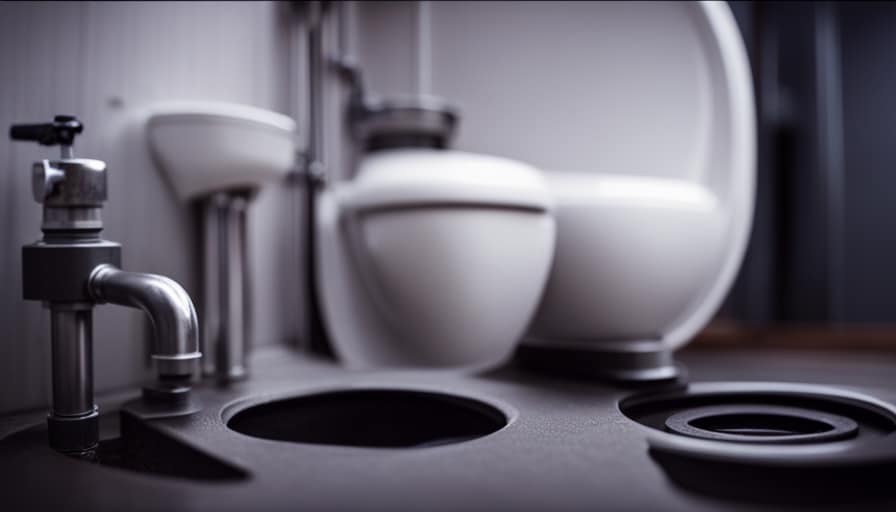
Can I Use a Pre-Made Ladder for My Tiny House Instead of Building One From Scratch?
Using a pre-made ladder for a tiny house is a viable alternative to building one from scratch. However, consider the pros and cons. Building allows customization, while buying offers convenience. Evaluate your needs and skills before deciding.
Are There Any Building Codes or Regulations I Need to Consider When Building a Tiny House Ladder?
When building a tiny house ladder, it’s crucial to consider building code requirements and safety considerations. Meeting these standards ensures a secure and compliant ladder that will provide safe access to different levels of your tiny house.
Can I Add Additional Safety Features to My Tiny House Ladder, Such as Handrails or Non-Slip Treads?
Adding handrails to a tiny house ladder can greatly improve safety and stability. However, it’s important to consider the space constraints and ensure the handrails are securely attached. Non-slip treads can also enhance traction and prevent accidents.
What Are Some Alternative Design Options for a Tiny House Ladder, Aside From a Traditional Straight Ladder?
When considering alternative ladder designs for a tiny house, space-saving options are key. Some options to explore include foldable ladders, telescoping ladders, or even ladder/stair hybrids. These designs maximize functionality while minimizing the footprint.
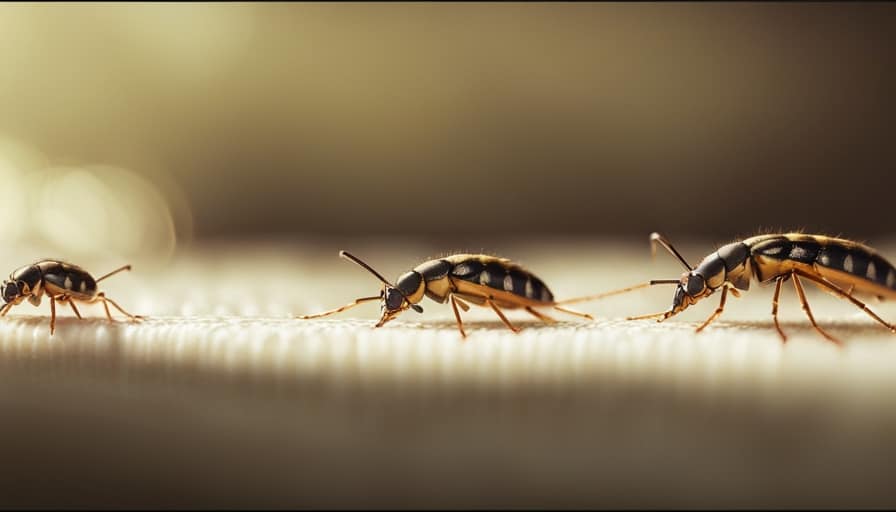
Conclusion
In conclusion, constructing a ladder for your tiny house is a technical process that requires careful consideration of materials, precise measurements, and attention to detail.
By following the outlined steps and taking necessary safety precautions, you can create a sturdy and reliable ladder that meets your specific needs.
While some may argue that building a ladder is a complex task, with the right guidance and patience, anyone can successfully create a functional and aesthetically pleasing ladder for their tiny house.
I’m Theodore, and I love tiny houses. In fact, I’m the author of Tiny House 43, a book about tiny houses that are also tree houses. I think they’re magical places where imaginations can run wild and adventures are just waiting to happen.
While tree houses are often associated with childhood, they can be the perfect adult retreat. They offer a cozy space to relax and unwind, surrounded by nature. And since they’re typically built on stilts or raised platforms, they offer stunning views that traditional homes simply can’t match.
If you’re looking for a unique and romantic getaway, a tree house tiny house might just be the perfect option.
-

 Beginners Guides2 weeks ago
Beginners Guides2 weeks agoHow To Buy A Tesla Tiny House
-

 Energy Efficiency2 months ago
Energy Efficiency2 months agoBest Tiny Homes For Cold Climates
-

 Beginners Guides1 week ago
Beginners Guides1 week agoTiny House Nation Where Are They Now Stephanie
-

 Tiny House Resources (e.g., legalities, cost, insurance, FAQs)2 months ago
Tiny House Resources (e.g., legalities, cost, insurance, FAQs)2 months agoDo Tiny Homes Need Planning Permission?
-

 Beginners Guides2 weeks ago
Beginners Guides2 weeks agoFrom The Show Tiny House Nation How Many Keep Their Tiny House?
-

 Beginners Guides2 months ago
Beginners Guides2 months agoUsing a Climbing Net For Treehouse Construction
-

 Beginners Guides2 months ago
Beginners Guides2 months agoHow to Build a Treehouse Without Drilling Into the Tree
-

 Beginners Guides3 weeks ago
Beginners Guides3 weeks agoTiny House Nation Who Pays For The Houses




